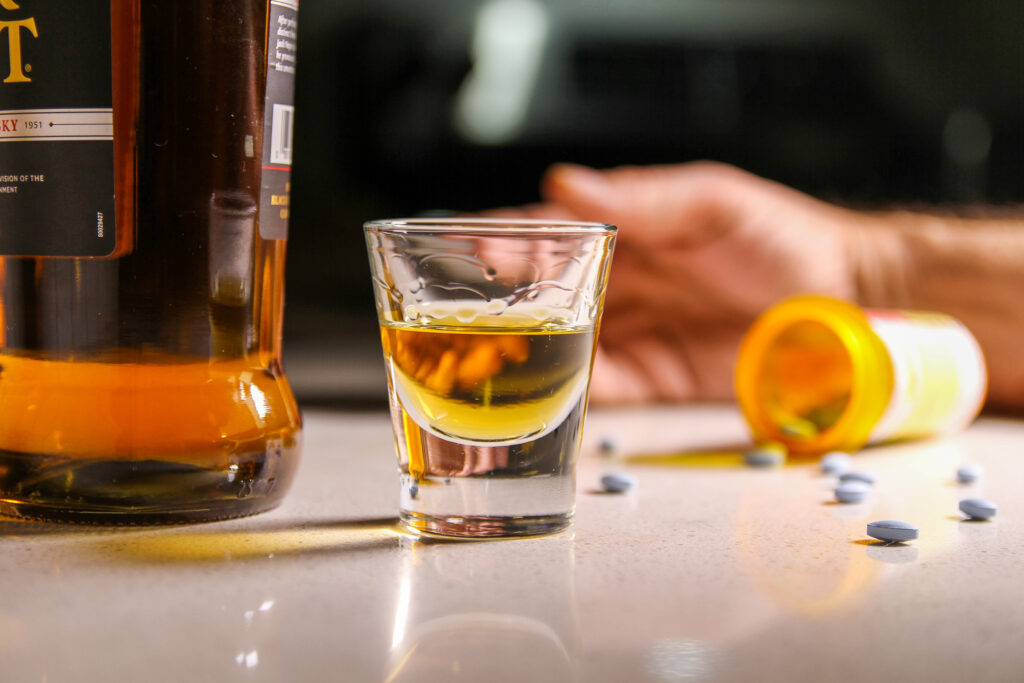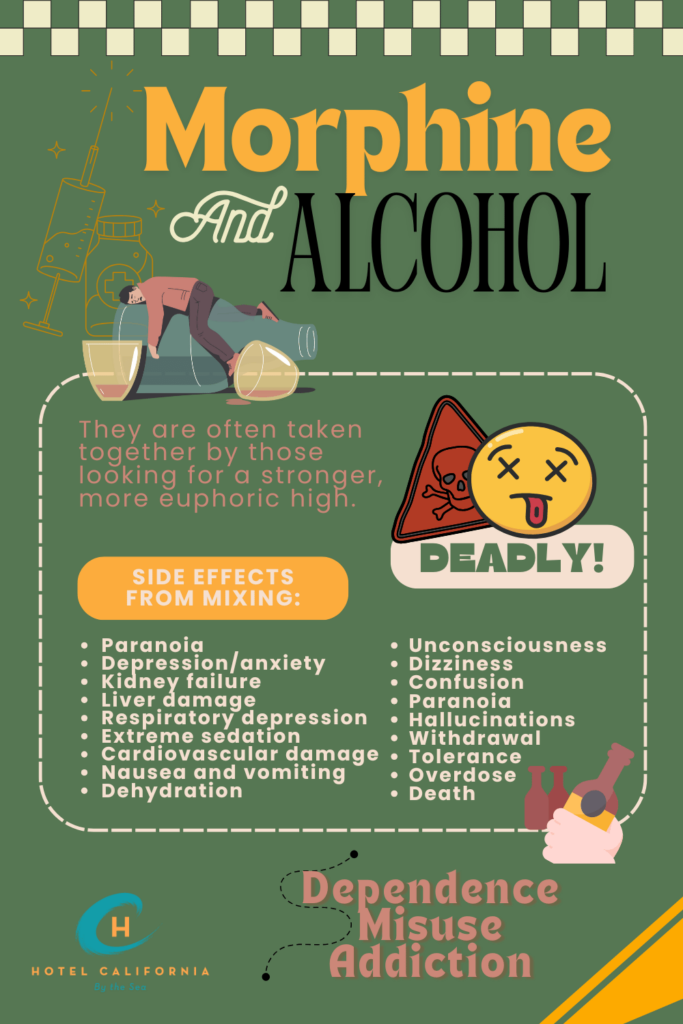What are the risks of Morphine and Alcohol?
Morphine and alcohol are a drug combination that can be very risky. When taken in high amounts, both substances on their own can be dangerous. When taken together, it can be deadly. Morphine is a popular pain reliever opioid generally used in emergency medicine and following surgery. Alcohol is a legal substance used socially within many different cultures worldwide. Both are central nervous system depressants that can lead to dependence and addiction to one or both drugs.

According to the World Health Organization, an estimated 115,000 people died of an opioid overdose in 2017. Opioids like morphine are generally safe when administered in a clinical setting under professional guidance. When abused and used recreationally, morphine can lead to addiction and severe side effects negatively impacting both physical and psychological aspects of a person’s life.
In 2020, research found that an estimated 1.34 billion people consumed alcohol worldwide. Alcohol is a naturally fermented product created by fruits, grains or veggies. When consumed, it slows down brain activity, heart rate and breathing rate. It can take an average of about 1 hour for the body to break down alcohol.
Taking two substances together at the same time or one after another is also known as polysubstance use. Taking morphine and alcohol together is an example of polysubstance use. Polysubstance abuse and addiction can be even more difficult to overcome. It often requires more intensive and longer treatment care.
More on Morphine
Morphine is a Schedule II controlled substance that is very potent and with very limited medical use. It is a non-synthetic narcotic opioid derived from the opium plant. There is a small percentage of morphine that is obtained from the plant and is used directly for pharmaceutical products. The remaining morphine that is processed is used for codeine and other opioid derivatives.
It belongs to a class of drugs called opioids. Opioids are used to treat moderate to severe pain. Depending on the type of opioid being used, it can help alleviate pain for up to 12 hours. Despite being very effective, they can also be very potent and can lead to dependence, misuse and overdose.
Morphine comes in various formulations, including immediate release and extended release as well as various modes of administration. Morphine can be injected where the medication is immediately released into the bloodstream or it can be taken orally.
Opioids such as morphine work by binding to and activating the opioid receptors on the nerve cells in the brain, spinal cord and other areas of the body. This allows the opioid to block the pain signals from traveling to the brain and ultimately produce feelings of pain relief. Morphine also floods the brain with dopamine, which produces feelings of euphoria while dampening the feeling of pain. This feeling is so powerful that it can become very addictive.

The effects of Alcohol
Despite being a legal substance, drinking too much can be dangerous and a risk to overall health. Alcohol is easily accessible and available. You can even find them at your local grocery store or specialty store. Alcohol has been a part of many different cultures for centuries. Yet, it still can be a dangerous substance.
About 20% of the alcohol you intake is absorbed into the bloodstream via the stomach. The rest of it goes through the small intestine. Drinking a small amount of alcohol can increase hunger due to the increased flow of stomach juices being activated when you consume the drink. Drinking large amounts of alcohol can lead to malnutrition, stomach ulcers and irritation of the stomach lining.
The liver is where most of the alcohol is usually broken down. About 90% of people who drink heavily will develop some sort of liver disease due to excessive alcohol use. Liver conditions such as fatty liver and liver cirrhosis are often directly linked to alcohol abuse.
The kidneys are also affected by alcohol abuse. Alcohol increases urine production. Alcohol is also a diuretic. Dehydration can cause all sorts of damaging issues to the brain and body.
The brain is one of the most important organs impacted by alcohol abuse. It can dull out parts of the brain that control executive and cognitive functions. Conditions such as mood, loss of coordination, slurred speech, blurred vision, difficulty with decision making and confusion are common side effects of brain damage due to alcohol.
Check Your Insurance Coverage for FREE
Find out if your insurance covers addiction treatment in minutes. We accept most insurance!
What happens when you combine Morphine and Alcohol?
Mixing morphine and alcohol can lead to risky consequences. They should not be used together. Why do people use both substances? Oftentimes, users mix the two drugs in an attempt to experience a stronger and more intense euphoric high. This might be the case, but it can also lead to an increased risk of dependence, misuse and addiction. The effects of both substances are amplified when taken together and can lead to an addiction to one or both drugs.
Studies have found that over 25% of adults with an opioid use disorder also have an alcohol use disorder. Those who binge drink are also more likely to misuse prescription medications that include opioids and morphine. Another study found that in 2017, about 15% of those who died of opioid related causes were also drinking alcohol.
Side effects of using Morphine and Alcohol
- Paranoia
- Confusion
- Kidney failure
- Liver damage
- Respiratory depression
- Extreme sedation
- Cardiovascular damage – irregular heart rate, changes in blood pressure
- Nausea and vomiting
- Dehydration
- Loss of coordination
- Unconsciousness
- Dizziness
- Lack of inhibition
- Unusual behavior
- Paranoia
- Depression and anxiety
- Hallucinations
- Increased risk of overdose – slowed or stopped breathing, weak pulse, pinpoint pupils, loss of consciousness, unresponsiveness, choking, pale or bluish skin, and a limp body
- Morphine and alcohol withdrawal – anxiety, depression, nausea, vomiting, diarrhea, muscle aches, rapid pulse, tremors, insomnia, fever, hallucinations and seizures
- Tolerance, dependence and addiction to one or both drugs
Reach out to Hotel California by the Sea
We specialize in treating addiction and other co-occurring disorders, such as PTSD. Our Admissions specialists are available to walk you through the best options for treating your addiction.
Treatment for Opioid Use Disorder and Alcohol Use Disorder
Mixing morphine and alcohol produces a euphoric high that can lead to a polysubstance addiction to both drugs. Research has found time and again that the combination of opioids and alcohol leads to dangerous consequences, especially when either or both are used in excess. For a person who is taking morphine, adding alcohol will only encourage them to use more morphine or alcohol in order to continue feeling the same effects. The combination of both impacts the central nervous system and slows down activity in the body to the point where cognitive functioning is impaired.
Is it ok to have 1 or 2 drinks while on morphine? No. It is not safe to drink any amount of alcohol while taking an opioid medication. Morphine is a long-acting opioid whose effects can last several hours. It is recommended to wait at least a week or more before consuming alcohol to make sure the drug is completely out of your system. Professional behavioral health treatment programs such as Hotel California by the Sea provide opioid use disorder treatment as well as alcohol use disorder treatment.
We provide support at all levels of care including detox, residential, PHP and IOP. We utilize evidence-based treatment methods such as CBT, DBT, and EMDR therapy to help our clients better understand their addiction. Hotel California by the Sea is dedicated to helping clients reach their goals in sobriety and overcome their addiction.
References:
https://pmc.ncbi.nlm.nih.gov/articles/PMC6870105/
https://zinniahealth.com/substance-use/morphine/with-alcohol
https://www.medicalnewstoday.com/articles/alcohol-and-opioid-use
https://www.goodrx.com/well-being/substance-use/opiates-and-alcohol
https://www.dea.gov/sites/default/files/2020-06/Morphine-2020.pdf
https://www.bicyclehealth.com/opioid-education/morphine/combining-with-alcohol
